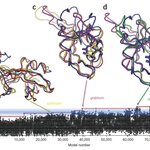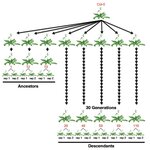Genetics & Molecular Biology

A new review has found evidence that a specific gene is linked to suicidal behavior, which may be one of the many complex causes of suicide.
In the past, studies have implicated the gene for brain-derived neurotrophic factor (BDNF) in suicidal behavior. BDNF is involved in the development of the nervous system. After pooling results from 11 previous studies and adding their own study data involving people with schizophrenia, scientists writing in
the International Journal of Neuropsychopharmacology found that among people with a psychiatric diagnosis, those with the methionine ("…

I'll lay out something a lot of people won't like to hear; science is about understanding the world according to natural laws and that means sometimes breaking the laws of nature. How far that goes is a policy matter and it's for civilian leadership to decide.
Researchers won't like being compared to the military but it's a lot like that; there is a job to do, a mission to accomplish, and the scope and limitations of that mission are determined by the public through their politicians but once that framework is established, it is up to the soldiers on the ground to decide how to get…

According to the Centers for Disease Control and Prevention, 33.8 percent of American adults are obese. placing them at increased risk for type 2 diabetes, coronary heart disease, stroke, and certain cancers. That's a lot of fat, but not all fat is bad.
When we picture body fat, what we are thinking of is white fat but another type, brown fat, does more - it burns body fat. It was once believed that brown fat disappeared after infancy but recent advances in imaging technology led to its rediscovery in adult humans
Because brown fat is so full of blood vessels and mitochondria (…

"It is not the strongest of the species that survives, not the most intelligent, but the one most responsive to change." — attributed to Charles Darwin.
There is general agreement that the arrangement of species, both extant and extinct conforms to a tree corresponding to descent with modification. While this clearly implies some evolutionary mechanism any proposed explanation can only be adequate if it correctly predicts the statistical characteristics of the structure and nodes of the descent tree and of the resulting species and their genetic codes.Nodes, or branching points in the tree…

I don't want to sound alarmist, but glow-in-the-dark animals are real-- and it's not just cute kitty-cats. As reported earlier here at Science 2.0, scientists did this and that to genetics to make AIDS-resistant cats. Part of the process includes splicing in jellyfish DNA so the cats glow in the dark.
Yes, not 'they glow because of the medical reason', they glow for the fun of it. They glow because the scientists wanted to track the progress of the other stuff, the real medical stuff they were doing.
It turns out jellyfish DNA for glow-in-the-dark is like the corn syrup of…

Retroviral proteases are a class of enzymes that play an important role in the maturation and proliferation of the AIDS virus. As such, this class of enzymes is a subject of intense research. The efforts, however, were hindered by a fundamental problem: nobody knew exactly what these enzymes looked like.
To resolve this issue, an online game, Foldit, was created by the University of WashingtonCenter for Game Science, in collaboration with the Baker lab in the Department of Biochemistry of the same university. The game provided direct manipulation tools and the assistance of a program called…

Recently, a lot of attention has gone to epigenetics, or heritable changes in gene expression caused by mechanisms other than changes in DNA sequence. An example of such a mechanism is DNA methylation, where a methyl group (CH3) binds to cytosine or adenine. Epigenetic changes might explain the discrepancies that are being discovered between what the genetic code dictates and how an organism actually looks and functions, ranging from flower shape to the tendency for obesity.
Now, a new study in Science has taken a look at the changes in the epigenetic code over several generations. To do…

Although genetic sequencing sounded exciting - I'll send you a tube full of spit, you tell me what diseases I'm going to get - the reality was less thrilling, and less useful. There are diseases with very specific and even single mutations, but the big 'uns - cardiovascular disease, cancer, diabetes - are more tangled and complicated than trying to find a redeeming quality in a Kardashian. Even with the ethical dilemmas involved and murky predictability, I still think the potential is fascinating. A story on the whole genome of a family of four, and how the research predicted the…

A research team at John Hopkins Medical Institutions has introduced synthetic chromosomes into yeast (Saccharomyces cerevisiae, see figure 1), in an effort to better understand how genomes work, and potentially allow some ‘control’ at genome level. As part of the synthetic yeast genome project, or Sc2.0, the researchers have introduced a synthetic right arm of the ninth chromosome, synIXR, and a partially synthetic left arm of the sixth, semisyn-VIL.
Figure 1: S. cerevisiae.
(Source: Wikimedia Commons, user: Masur)
This was done while adhering to three design…

We all know a high-fat diet is going to be bad for most people, but why?
A study in mice showed that those lacking the gene-expression-controlling enzyme HDAC3 that were fed a high-fat diet experienced rapid thickening of the heart muscle and heart failure. A molecular link between fat intake and an enzyme tasked with regulating gene expression, at least in mice, may be a target for combating heart disease.
The team found that the engineered mice without the enzyme HDAC3 tended to under-express genes important in fat metabolism and energy production. Essentially, when fed a high-…